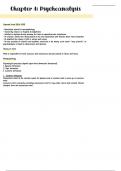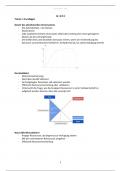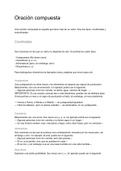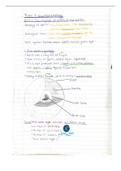WEEK 1: Introduction to Tort Law
How to study for Tort Law:
1. Make an outline
2. Work in study groups
3. Use the online resource centre
4. You are responsible for readings, class lectures, and lecture slides
Introduction: Comparative approach – compare things
“German professors typically present systematic lists of rules of events, the longer the better; French
lawyers explore abstract concepts, ideally through binary oppositions; and English legal scholars, if
they bother to come at all, mostly tell stories.” (Hugh Collins, The European Civil Code: The Way
Forward (Cambridge: Cambridge University Press, 2008), 256.
Objectives of the class: Identify and compare the main difference and similarities in tort law
between common law and European based legal systems (DCFR) in:
Legal sources
Legal reasoning
Purposes
And identify and describe the main elements of the DCFR.
Tort law is NOT criminal law or contract law. However, the same set of facts can give
rise to tort, criminal and contract liability.
It is about liability and responsibility. Holding them responsible in a different way. In criminal law, it
is society holding them responsible, depending on crime in the jurisdiction that they are convicted.
Accountability creates a liability. There is a pen alty for this. It could be a fine, a jail sentence, etc.
Keyword is accident. In Criminal law: you need intention, a Mens Rea. Not by accident. In Tort law,
it is an accident. Intentionally poking someone in the eye, and meet the definition of the
statute/law, then if it is not. Then it is not criminal law. It is tort law.
Ex. There is a law that said that it is a criminal event when you poke someone in the eye, you can go
to jail for 30 days. Society tries to keep people from poking people in the eye, to stop getting people
from eye poking. The person who got their eye poked, might have lost their sight. A lot of surgeries,
pain and money – it is a loss. In Tort law, the people who destroyed your eye will be responsible for
paying you and accountable for your damages. Accountable for pain and suffering. Compensate the
payments made for the eye reparations. Tort law helps the accountability mode between
individuals, not between individual and State (Criminal law). Who is accountable to who for what?
Vocabulary and terms of art
Tort Synonym: a non-contractual liability – liability that arises out of actions either
intentionally or negligently that cause damage to others
Damage any type of detrimental effect, injury, damages can also be synonymous with
reparations or compensation – the effect of the injury on her OR can be what the person can
do to make it right again
Legally relevant damage (DCFR) Losses (economic and non-economic nature) and injury
Reparation/remedy legal consequences of a (legally relevant) damage that has already
occured
, Compensation – monetary reparation
Grounds of accountability (DCFR) – Intention, negligence and accountability without
intention nor negligence (strict liability)
Plaintiff – claimant, victim, injured party
Defendant – tortfeasor
Prima facie – if it is true, the facts alleged will allow recovery
Dismissal – do the facts of the claim state a claim if true?
Summary judgement – does the evidence support the claim?
Elemental Comparative Law
1. Methods – compare two different legal traditions by selecting and comparing data
points
2. Methods in this course - Compare representative forms of sources. In this course
we are not comparing actual sources, but rather representations of those sources.
I.e. representative casses rather than the case from a particular jurisdiction and the
Draft Common Frame of Reference rather than codes from specific European
countries.
3. Compare legal reasoning methods
4. Compare the functional purpose of tort law in society
COMMON LAW COUNTRIES
Principle is extracted from case law
Rules are decided and applied based on the relevant facts
Common law principle: A court should follow the decisions of prior courts that have ruled
on similar cases to produce a predictable outcome. A court that hears a case that presents
a new problem or “case of first impression’ has the obligation to find the appropriate legal
rule. This case becomes the precedent. A precedent can be either binding or persuasive. A
decision from a superior court or from the same court on the same set of facts is binding
precedent under the doctrine of stare decisis. Decisions from other jurisdictions or parallel
courts are persuasive. Established principles should not be disturbed.
Judges like consistency – whether in Common or Civil Law countries.
Sources of Law in Common Law - All three have equal importance
1. Case law - binding precedent
2. Statutory law - is written law passed by a body of legislature
3. Regulatory law - refers to law promulgated by an executive branch agency under a
delegation from a legislature
Legal reasoning methods:
The rule is extracted from a case in your jurisdiction where a court has decided the matter based on
the same or similar facts. Lawyers find a case with identical facts (at least similar) and extract a rule
of law from the holding in that case. The lawyers then argue that prior decision is binding on the
current case because of stare decisis or, in the event it is not binding, it is persuasive. The entire
argument is based on the similarity of facts between the two cases. Lawyers on the other side of the
case may argue that the principle of law does not apply because the facts are different or because
the case is from a different court system that treats the issue differently. This is called
“distinguishing the case.”
,Directed verdict – did the plaintiff prove his or her case at trial
Functional purpose of Tort Law – COMMON LAW
1. Corrective justice - (Ex Post) – making the injured party whole – certain amount of money
will make the person whole – try to make the person whole with monetary worth
2. Deterrence of future wrongdoing (Ex Ante)
Corrective action for the benefit of the entire society
Corrective private action in place of governmental action
Requires an open, accessible court system
Civil Law - European Code - based legal system – we have mostly codes
CIVIL LAW COUNTRIES
Statutory law: Civil Codes
3. French Civil Code - Court Civil, Code Napoleon, 1804
4. German Civil Code - Burgerliches Gesetzbuch, 1900 BGB – extremely precise. Not to be read
by the laid people. Composed of 5 parts.
5. Italian Civil Code - Codice Civile Italiano, 1942
General rules of the codes:
Rules are laid down by the legislator – general rules (no case law!) that allow national
courts to further develop this area of law
Systematic approach
Academic writings are very important in the development of the law (private law) – E.g. BGB
is also known as Professorenrecht (law made by professors). National courts very often
discuss the opinions of legal authors in their decisions.
Case law is not equal to the role of common law. Case Law has developed the area of law
because the legislator has not drafted specific rules to cover each aspect of everyday life.
Case law plays a role in Civil Law as well.
Legal reasoning:
European Code-based legal systems (DCFR)
Deductive method of legal reasoning: from general to particular
Lawyers start by analysing the legal rule and then they apply it to the facts of the specific
case at issue
Purpose of tort law – European Code-based legal systems
1. Reparation (ex post)
The purpose of tort law is to restore as exactly as possible the status quo that was disturbed by the
harm and to restore the victim to the situation in which he would have been in the wrongful act
had not occurred. E.g., in kind or through monetary compensation. Example destroying a window –
the window would have to be restored. Leg has been destroyed, then there needs to be given
monetary compensation. Insurances, for example if you cannot pay.
, 2. Recognition (ex post)
Recognition that the victim has suffered a wrong or that his/her right has been infringed. (C. Van
Dam, European Tort Law, p. 349) Ex. The person has been punched in the face, something bad
happened. Does not really have a damage, very minimal. People suffered a certain wrong without a
specific monetary loss, sometimes it is important to have it recognized.
Example: Nominal damages or a court’s decision that someone’s right is infringed.
3. Prevention (ex ante) – Art. 1:102 DCFR
Be careful: distinction between prevention, punishment and deterrence. Tort law is not
criminal law. Civil law it is even stronger. Tort law is to provide liability or compensation,
restore to the situation before the accident happened. Not punishment. However, there are
some situations there are punishment aspects. Ex. Courts will award very high damages
(punitive damages). EU system does not have punitive damages.
Draft Common Framework of Reference: no punitive damages – not consistent with the
principle of reparation. Very limited situations – specific violations of personality rights.
Reputation of person or privacy.
Ex. Caroline of Monaco, article was not true. Photographs were created and made up.
Newspaper made it intentionally. Court of appeal awarded damages. 15000 euro was
awarded. Higher court of Germany made it 92000 euros.
Very limited in the Civil law system.
European Tort Law
Legislation of the EU (treaty provisions, regulations, directives and case law CJEU)
ECHR (case law of the European Court of Human Rights) – no specific tort law conditions,
establishment of tort liability
National tort laws in Europe
Code-based jurisdictions
Common law jurisdictions: England, Ireland, Cyprus and Malta
Are Europe’s national legal systems converging? Is there a European legal tradition in tort
law?
Ius commune – The search for a European Ius Commune (in tort law) - origin of the idea of ius
commune based on the fundamentals of Roman Law: 12 th century with the discovery of the
Justinian’s Digest.
“Law, in the Middle Ages, was not conceived of as a system of rules enacted for, and exclusively
applicable within, a specific territory, and thus the ius commune provided the cornerstone for the
emergence of an essentially unified, European legal tradition.” (Zimmerman, ´Characteristic Aspect
of German Legal Culture’, p. 2-3)
Ius Commune – cover all different systems, finds certain similarities between systems. With those
similarities you are able to pass or create norms or create certain new customs for certain
territories. Customary law – made up with certain customs, has repetition. Ex. Lex mercatoria. can
divide the territory. Used at perspective of the jurists. Are there similarities, what can link the
system?
18th and 19th century: process of nationalization and codification of private laws. E.g. French
Civil Code. Moment when nations started to see that they are different from the others.
How to study for Tort Law:
1. Make an outline
2. Work in study groups
3. Use the online resource centre
4. You are responsible for readings, class lectures, and lecture slides
Introduction: Comparative approach – compare things
“German professors typically present systematic lists of rules of events, the longer the better; French
lawyers explore abstract concepts, ideally through binary oppositions; and English legal scholars, if
they bother to come at all, mostly tell stories.” (Hugh Collins, The European Civil Code: The Way
Forward (Cambridge: Cambridge University Press, 2008), 256.
Objectives of the class: Identify and compare the main difference and similarities in tort law
between common law and European based legal systems (DCFR) in:
Legal sources
Legal reasoning
Purposes
And identify and describe the main elements of the DCFR.
Tort law is NOT criminal law or contract law. However, the same set of facts can give
rise to tort, criminal and contract liability.
It is about liability and responsibility. Holding them responsible in a different way. In criminal law, it
is society holding them responsible, depending on crime in the jurisdiction that they are convicted.
Accountability creates a liability. There is a pen alty for this. It could be a fine, a jail sentence, etc.
Keyword is accident. In Criminal law: you need intention, a Mens Rea. Not by accident. In Tort law,
it is an accident. Intentionally poking someone in the eye, and meet the definition of the
statute/law, then if it is not. Then it is not criminal law. It is tort law.
Ex. There is a law that said that it is a criminal event when you poke someone in the eye, you can go
to jail for 30 days. Society tries to keep people from poking people in the eye, to stop getting people
from eye poking. The person who got their eye poked, might have lost their sight. A lot of surgeries,
pain and money – it is a loss. In Tort law, the people who destroyed your eye will be responsible for
paying you and accountable for your damages. Accountable for pain and suffering. Compensate the
payments made for the eye reparations. Tort law helps the accountability mode between
individuals, not between individual and State (Criminal law). Who is accountable to who for what?
Vocabulary and terms of art
Tort Synonym: a non-contractual liability – liability that arises out of actions either
intentionally or negligently that cause damage to others
Damage any type of detrimental effect, injury, damages can also be synonymous with
reparations or compensation – the effect of the injury on her OR can be what the person can
do to make it right again
Legally relevant damage (DCFR) Losses (economic and non-economic nature) and injury
Reparation/remedy legal consequences of a (legally relevant) damage that has already
occured
, Compensation – monetary reparation
Grounds of accountability (DCFR) – Intention, negligence and accountability without
intention nor negligence (strict liability)
Plaintiff – claimant, victim, injured party
Defendant – tortfeasor
Prima facie – if it is true, the facts alleged will allow recovery
Dismissal – do the facts of the claim state a claim if true?
Summary judgement – does the evidence support the claim?
Elemental Comparative Law
1. Methods – compare two different legal traditions by selecting and comparing data
points
2. Methods in this course - Compare representative forms of sources. In this course
we are not comparing actual sources, but rather representations of those sources.
I.e. representative casses rather than the case from a particular jurisdiction and the
Draft Common Frame of Reference rather than codes from specific European
countries.
3. Compare legal reasoning methods
4. Compare the functional purpose of tort law in society
COMMON LAW COUNTRIES
Principle is extracted from case law
Rules are decided and applied based on the relevant facts
Common law principle: A court should follow the decisions of prior courts that have ruled
on similar cases to produce a predictable outcome. A court that hears a case that presents
a new problem or “case of first impression’ has the obligation to find the appropriate legal
rule. This case becomes the precedent. A precedent can be either binding or persuasive. A
decision from a superior court or from the same court on the same set of facts is binding
precedent under the doctrine of stare decisis. Decisions from other jurisdictions or parallel
courts are persuasive. Established principles should not be disturbed.
Judges like consistency – whether in Common or Civil Law countries.
Sources of Law in Common Law - All three have equal importance
1. Case law - binding precedent
2. Statutory law - is written law passed by a body of legislature
3. Regulatory law - refers to law promulgated by an executive branch agency under a
delegation from a legislature
Legal reasoning methods:
The rule is extracted from a case in your jurisdiction where a court has decided the matter based on
the same or similar facts. Lawyers find a case with identical facts (at least similar) and extract a rule
of law from the holding in that case. The lawyers then argue that prior decision is binding on the
current case because of stare decisis or, in the event it is not binding, it is persuasive. The entire
argument is based on the similarity of facts between the two cases. Lawyers on the other side of the
case may argue that the principle of law does not apply because the facts are different or because
the case is from a different court system that treats the issue differently. This is called
“distinguishing the case.”
,Directed verdict – did the plaintiff prove his or her case at trial
Functional purpose of Tort Law – COMMON LAW
1. Corrective justice - (Ex Post) – making the injured party whole – certain amount of money
will make the person whole – try to make the person whole with monetary worth
2. Deterrence of future wrongdoing (Ex Ante)
Corrective action for the benefit of the entire society
Corrective private action in place of governmental action
Requires an open, accessible court system
Civil Law - European Code - based legal system – we have mostly codes
CIVIL LAW COUNTRIES
Statutory law: Civil Codes
3. French Civil Code - Court Civil, Code Napoleon, 1804
4. German Civil Code - Burgerliches Gesetzbuch, 1900 BGB – extremely precise. Not to be read
by the laid people. Composed of 5 parts.
5. Italian Civil Code - Codice Civile Italiano, 1942
General rules of the codes:
Rules are laid down by the legislator – general rules (no case law!) that allow national
courts to further develop this area of law
Systematic approach
Academic writings are very important in the development of the law (private law) – E.g. BGB
is also known as Professorenrecht (law made by professors). National courts very often
discuss the opinions of legal authors in their decisions.
Case law is not equal to the role of common law. Case Law has developed the area of law
because the legislator has not drafted specific rules to cover each aspect of everyday life.
Case law plays a role in Civil Law as well.
Legal reasoning:
European Code-based legal systems (DCFR)
Deductive method of legal reasoning: from general to particular
Lawyers start by analysing the legal rule and then they apply it to the facts of the specific
case at issue
Purpose of tort law – European Code-based legal systems
1. Reparation (ex post)
The purpose of tort law is to restore as exactly as possible the status quo that was disturbed by the
harm and to restore the victim to the situation in which he would have been in the wrongful act
had not occurred. E.g., in kind or through monetary compensation. Example destroying a window –
the window would have to be restored. Leg has been destroyed, then there needs to be given
monetary compensation. Insurances, for example if you cannot pay.
, 2. Recognition (ex post)
Recognition that the victim has suffered a wrong or that his/her right has been infringed. (C. Van
Dam, European Tort Law, p. 349) Ex. The person has been punched in the face, something bad
happened. Does not really have a damage, very minimal. People suffered a certain wrong without a
specific monetary loss, sometimes it is important to have it recognized.
Example: Nominal damages or a court’s decision that someone’s right is infringed.
3. Prevention (ex ante) – Art. 1:102 DCFR
Be careful: distinction between prevention, punishment and deterrence. Tort law is not
criminal law. Civil law it is even stronger. Tort law is to provide liability or compensation,
restore to the situation before the accident happened. Not punishment. However, there are
some situations there are punishment aspects. Ex. Courts will award very high damages
(punitive damages). EU system does not have punitive damages.
Draft Common Framework of Reference: no punitive damages – not consistent with the
principle of reparation. Very limited situations – specific violations of personality rights.
Reputation of person or privacy.
Ex. Caroline of Monaco, article was not true. Photographs were created and made up.
Newspaper made it intentionally. Court of appeal awarded damages. 15000 euro was
awarded. Higher court of Germany made it 92000 euros.
Very limited in the Civil law system.
European Tort Law
Legislation of the EU (treaty provisions, regulations, directives and case law CJEU)
ECHR (case law of the European Court of Human Rights) – no specific tort law conditions,
establishment of tort liability
National tort laws in Europe
Code-based jurisdictions
Common law jurisdictions: England, Ireland, Cyprus and Malta
Are Europe’s national legal systems converging? Is there a European legal tradition in tort
law?
Ius commune – The search for a European Ius Commune (in tort law) - origin of the idea of ius
commune based on the fundamentals of Roman Law: 12 th century with the discovery of the
Justinian’s Digest.
“Law, in the Middle Ages, was not conceived of as a system of rules enacted for, and exclusively
applicable within, a specific territory, and thus the ius commune provided the cornerstone for the
emergence of an essentially unified, European legal tradition.” (Zimmerman, ´Characteristic Aspect
of German Legal Culture’, p. 2-3)
Ius Commune – cover all different systems, finds certain similarities between systems. With those
similarities you are able to pass or create norms or create certain new customs for certain
territories. Customary law – made up with certain customs, has repetition. Ex. Lex mercatoria. can
divide the territory. Used at perspective of the jurists. Are there similarities, what can link the
system?
18th and 19th century: process of nationalization and codification of private laws. E.g. French
Civil Code. Moment when nations started to see that they are different from the others.












